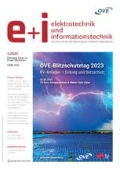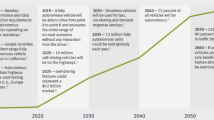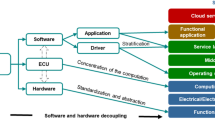Abstract
Development of embedded automotive systems has become tremendously complex in recent years. The trend of replacing traditional mechanical systems by modern embedded systems, and the launch of automotive multi-core systems enable deployment of more advanced control strategies. However, these applications require different safety concepts with different levels of criticality; and providing consistency of the safety concept during the entire product lifecycle is a tedious task. Additionally, new automotive safety standards, such as ISO 26262, and the de-facto industry standard AUTOSAR require efficient and consistent product development and tool support. The aim of the presented work is to establish a model-driven system and safety-engineering framework to support the seamless description of safety-critical systems, from requirements at the system level to final component implementation.
Zusammenfassung
Die Komplexität von Embedded Systems im Automobil hat in den letzten Jahren enorm zugenommen. Der Trend, etablierte, mechanische Systeme durch moderne eingebettete Controller zu ersetzen und die Einführung von speziell für den Einsatz im Kraftfahrzeug konzipierten Multi-Core-Systemen ermöglicht die Entwicklung von ausgeklügelten Fahrassistenz- und Komfortfunktionen. Allerdings fordern diese Anwendungen unterschiedliche Sicherheitskonzepte mit unterschiedlichen Kritikalitätsstufen und die Einhaltung dieser Richtlinien während der gesamten Produktentwicklung. Die Einführung des neuen Automotive-Sicherheitsstandards ISO 26262 und der Industriestandard AUTOSAR erfordern zusätzlich effiziente und konsequente Produktentwicklung und Werkzeugunterstützung. Das Ziel der vorgestellten Arbeit ist es, ein Modell-basiertes Entwicklungsframework zur Unterstützung der durchgängigen Beschreibung von sicherheitskritischen Systemen von Defintion der Anforderungen auf Systemebene zur Komponentenentwicklung zu ermöglichen.




Similar content being viewed by others
References
AUTOSAR Development Cooperation (2009): AUTOSAR AUTomotive open system architecture.
AUTOSAR Development Cooperation (2013): Virtual functional bus. Online.
Broy, M., Feilkas, M., Herrmannsdoerfer, M., Merenda, S., Ratiu, D. (2010): Seamless model-based development: from isolated tool to integrated model engineering environments. Proc. IEEE, 98(4), 526–545.
Ebert, C., Jones, C. (2009): Embedded software: facts, figures, and future. Computer, 42(4), 42–52.
Giese, H., Hildebrandt, S., Neumann, S. (2010): Model synchronization at work: keeping SysML and AUTOSAR models consistent. In LNCS (Vol. 5765, pp. 555–579).
Hilbrich, R., Goltz, H.-J. (2011): Model-based generation of static schedules for safety critical multi-core systems in the avionics domain. In WMSE11.
Hilbrich, R., van Kampenhout, J. R., Goltz, H.-J. (2012): Modellbasierte Generierung statischer Schedules fuer sicherheitskritische, eingebettete Systeme mit Multicore-Prozessoren und harten Echtzeitanforderungen. In Informatik aktuell (S. 29–38).
Holtmann, J., Meyer, J., Meyer, M. (2011): A seamless model-based development process for automotive systems. In R. Reussner, A. Pretschner, S. Jähnichen (Eds.), Software engineering (workshops). LNI (Vol. 184, pp. 79–88). Bonn: GI.
ISO—International Organization for Standardization (2011): ISO 26262 road vehicles functional safety, Part 1-10.
Kluge, F., Yu, C., Mische, J., Uhrig, S., Ungerer, T. (2009): Implementing AUTOSAR scheduling and resource management on an embedded SMT processor. In 12th international workshop on software & compilers for embedded systems (pp. 33–42).
Macher, G. (2014): Seamless model-based safety engineering from requirement to Implementation. In B. Baudry (Ed.), Proceedings of doctoral symposium co-located with 17th international conference on model driven engineering languages and systems (2014), Valencia, Spain, September 30. CEUR workshop proceedings (Vol. 1321).
Macher, G., Armengaud, E., Kreiner, C. (2014): Automated generation of AUTOSAR description file for safety-critical software architectures. In Lecture notes in informatics.
Macher, G., Armengaud, E., Kreiner, C. (2014): Bridging automotive systems, safety and software engineering by a seamless tool chain. In 7th European congress embedded real time software and systems proceedings (pp. 256–263).
Macher, G., Atas, M., Armengaud, E., Kreiner, C. (2014): Automotive real-time operating systems: a model-based configuration approach. In ACM SIGBED review special interest group on embedded systems. Association for Computing Machinery, Special Interest Group on Embedded.
Mader, R. (2012): Computer-aided model-based safety engineering of automotive systems. PhD thesis, Graz University of Technology.
Mader, R., Obendrauf, R., Prinz, P., Grießnig, G. (2014): Experience report: a safety engineering tool supporting error model creation and visualization. In Proceedings of the 2014 IEEE 25th international symposium on software reliability engineering, ISSRE ’14 (pp. 255–266). Washington: IEEE Computer Society.
OSEK/VDX Steering Committee (2005): OSEK/VDX operating systems. http://portal.osek-vdx.org/files/pdf/specs/os223.pdf, February.
Pagel, M., Broerkens, M. (2006): Definition and generation of data exchange formats in AUTOSAR, process independent model. In LNCS (Vol. 4066, pp. 52–65).
Quadri, I. R., Sadovykh, A. (2011): MADES: a SysML/MARTE high level methodology for real-time and embedded systems.
Rajan, A., Wahl, T. (2012): CESAR project book. Berlin: Springer.
Scheidemann, K., Knapp, M., Stellwag, C. (2010): Load balancing in AUTOSAR-multicore-systemen. Haar: WEKA Fachmedien GmbH.
Zurawka, T., Schaeuffele, J. (2006): Automotive Software Engineering – Grundlagen, Prozesse, Methoden und Werkzeuge effizient einsetzen (3. Aufl.). Wiesbaden: Vieweg.
Acknowledgements
The authors would like to acknowledge the financial support of the “COMET K2—Competence Centers for Excellent Technologies Programme” of the Austrian Federal Ministry for Transport, Innovation and Technology (BMVIT), the Austrian Federal Ministry of Economy, Family and Youth (BMWFJ), the Austrian Research Promotion Agency (FFG), the Province of Styria, and the Styrian Business Promotion Agency (SFG).
Furthermore, we would like to express our thanks to our supporting project partners, AVL List GmbH, Virtual Vehicle Research Center, and Graz University of Technology.
Author information
Authors and Affiliations
Corresponding author
Rights and permissions
About this article
Cite this article
Macher, G., Stolz, M., Armengaud, E. et al. Filling the gap between automotive systems, safety, and software engineering. Elektrotech. Inftech. 132, 142–148 (2015). https://doi.org/10.1007/s00502-015-0301-x
Received:
Accepted:
Published:
Issue Date:
DOI: https://doi.org/10.1007/s00502-015-0301-x




